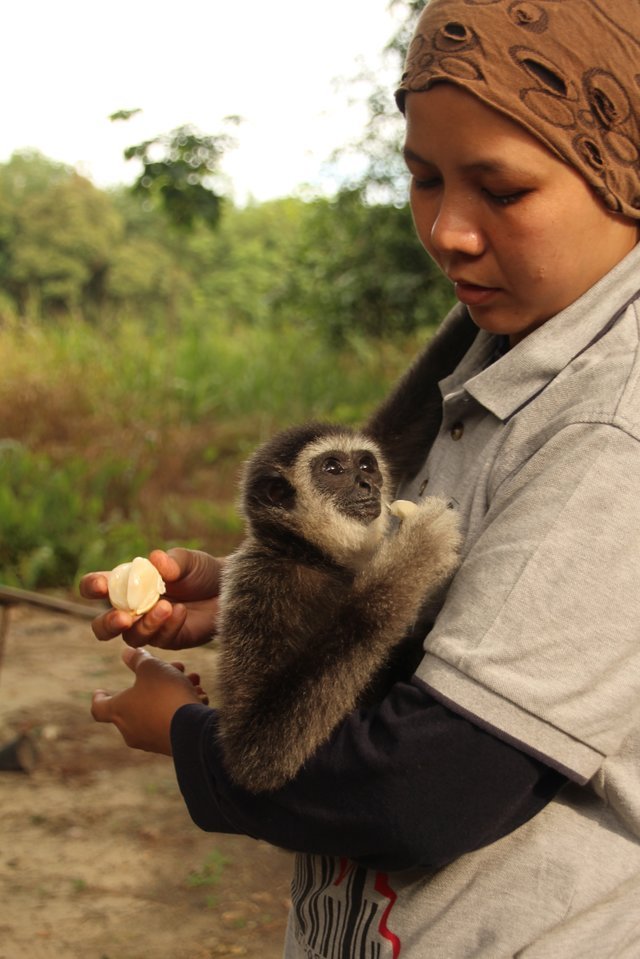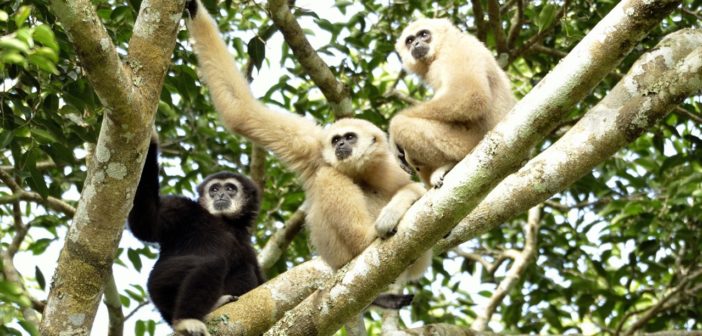Today (Tuesday) is International Gibbon Day and events are being organised around the world to foster awareness about the endangered primates and raise money for gibbon conservation.
Gibbons live in tropical and subtropical rainforests from eastern Bangladesh and northeastern India to southern China and Indonesia.
There are twenty recognised gibbon species. On the IUCN Red List of Threatened Species, four are listed as critically endangered, 14 as endangered, and one as vulnerable. One has yet to be assessed.
The major threats to gibbons include loss of habitat and hunting pressure, often for the wildlife trade.
To mark the gibbons’ special day, Changing Times focuses on the plight of the primates in Malaysia, and the work of the founder of the Gibbon Protection Society Malaysia (GPSM), Mariani Ramli.
 “Gibbons are so, so special,” Ramli said. “They are the kings of brachiation [swinging by their arms through the trees]. They go fast through the jungle. And they are the only monogamous primates.
“Gibbons are so, so special,” Ramli said. “They are the kings of brachiation [swinging by their arms through the trees]. They go fast through the jungle. And they are the only monogamous primates.
“Male and female gibbons live together as a family for their whole lives.”
Ramli is currently caring for six gibbons and two dusky leaf monkeys, also known as spectacled langurs, in a jungle area of Pahang.
She has applied to the Ministry for National Resources and Environment for a permit to set up the country’s first rehabilitation centre for gibbons.
Gibbons, who are also referred to as “smaller apes”, are not only losing their habitat because of deforestation; they are also being trafficked as pets.
“The pet trade is booming in Southeast Asia, especially in Malaysia and Thailand,” Ramli said. “The gibbons’ family bonding is so strong that, if one of them is threatened, the others will come to its defence.
“To get a baby gibbon, the poachers kill the parents and the siblings.”
The GPSM is holding a major Gibbon Day event at Sunway University in Kuala Lumpur on November 1 and is fundraising to cover the costs.
The main objective of the event, Ramli says, is to raise awareness among Malaysian teenagers about the trade in gibbons.
“The demand for illegal pet gibbons online is increasing dramatically and we need to connect with the younger influential generation, to help them make a stand against this illegal pet trade.
Ramli also wants Malaysians to see that gibbons are important. Gibbons, she says, are just as important to the ecosystem as orangutans. “There are a few tree species whose seeds are only dispersed by gibbons,” she said.
Malaysia, Ramli says, is the only country that is home to gibbons, but does not have a specific protection strategy for the primates, or a special rehabilitation centre.
“They are the forgotten apes in Malaysia,” she said.
“Gibbons are a protected species in Malaysia, but there is no specific action plan for gibbon conservation here, whereas there are in Thailand, Indonesia, Laos, and India, and in few more countries within Southeast Asia.”
There are specific conservation programmes in Malaysia for tigers, elephants, bears, and tapirs, Ramli says, but not for gibbons.
Malaysia is home to the largest gibbon, the siamang (Symphalangus syndactylus), and the smallest, the agile gibbon (Hylobates agilis). There are four species and one subspecies and the commonest gibbons in the country are the siamang and the lar gibbon (Hylobates lar), also known as the white-handed gibbon.
It is not known how many gibbons remain in the wild in Malaysia, Ramli says. “The last survey was in the 1980s, when data for peninsular Malaysia suggested there were 29,000 siamangs, 46,000 lar gibbons, and 4,000 agile gibbons.”
The siamang, lar, and agile gibbons are all listed as endangered.
The gibbons’ diet largely consists of fruit but they also eat leaves, flowers, seeds, tree bark, and plant shoots as well as insects, spiders, and bird eggs. They have very individual tastes, like humans, Ramli says.
Unlike orangutans, gibbons don’t build nests.
Gibbons, Ramli says, are not like the macaques or the langur monkeys, who go into urban areas.
“They are shy animals; they will stay in the jungle. And they won’t go down to the ground. They are highly arboreal, and there are bacteria on the soil that can harm them.
“They are particularly vulnerable because, if the forest where they live is fragmented, they cannot cross to another area so they get isolated in small patches.”
Ramli hopes that the gibbon will one day become one of Malaysia’s ambassadors, and receive the kind of attention and help that is given to its larger and more well-known relative, the orangutan.





